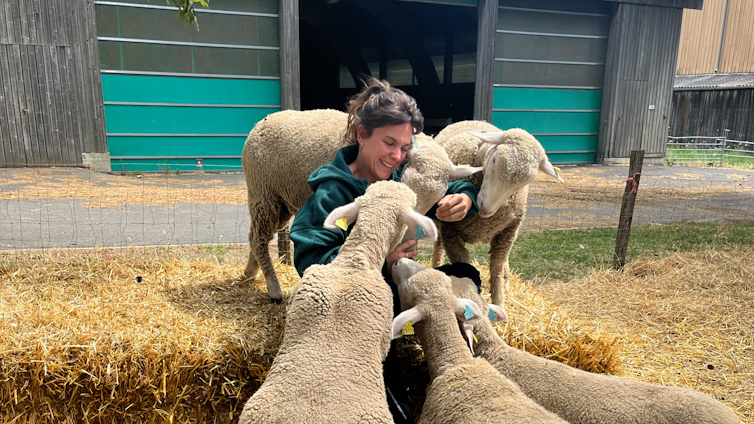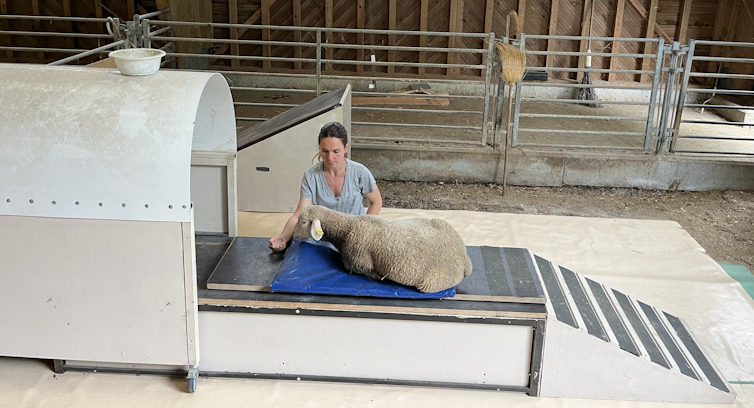To study the cognitive and communication abilities of sheep, MRI is a great tool for obtaining images of their brains. It took more than nine months of training for sheep to be able to stay still for several minutes in order to obtain good quality images. Before this study, dogs were the only species that had been able to successfully complete this training.
The sheep is a social animal that lives in groups and uses different means of communication with its peers (visual, auditory, olfactory, etc.). As part of my thesis project, I am interested in the way in which sheep interact with each other through their bleating. To do this, I use magnetic resonance imaging (MRI), a non-invasive neuroimaging technique that allows us to explore the functioning of the brain.
However, whatever the species, MRI imposes a major constraint: the participant must remain still for several minutes (up to five consecutive minutes) for the duration of the examination, which takes place in a noisy environment – up to ‘at 120 decibels (equivalent to a Formula 1 circuit) – and confined in a narrow tunnel.
Provided by the author
The specific conditions of the MRI environment (immobility, noise, confinement) can generate apprehension or even stress in the participant. For sheep, staying still is a real challenge, and so far anesthesia was the only method used to perform MRIs with this species.
Do not use anesthesia
Although anesthesia makes it easier to obtain usable images, it carries risks for the animal, such as side effects (respiratory and/or cardiovascular problems, difficulty waking up, allergy to anesthetic agents, etc.) and stress. It also modifies brain activity, which compromises the study of brain function. For these reasons, we chose not to use general anesthesia. We therefore took on the challenge of carrying out MRI examinations with awake sheep and without the use of restraint.
So far, the dog was the only non-human animal species to have been successfully trained to perform such feats.
Inspired by their methods, we developed an MRI training protocol based on positive reinforcement (food reward, caresses), adapted to sheep, in order to answer the following question: how to get a sheep to stay still throughout the duration of the MRI exam, in a confined and noisy space, while being separated from other people?

Provided by the author
There are four of us coaches (Scott Love, Céline Parias, Didier Dubreuil and me) who agreed to take on the challenge! From the birth of the lambs, we had positive interactions with them twice a day, every day of the week for a month, in the nursery of theOrfrasière Animal Physiology Experimental Unitat the INRAE Val de Loire center, in Nouzilly (Indre-et-Loire). During these positive interactions, we would place ourselves in the lambs’ pen and wait for them to come and interact with us. Then we offered them exercises related to MRI.
Training that begins at birth
This habituation phase allowed us to identify the lambs most familiar with the trainers and the most receptive to the exercises. We then chose ten lambs (five females: Maggie, Brook, Lily, Barnita, Robin; five males: Joe, Ted, Leonard, Jackson, Tony) to participate in the MRI training protocol.
Given that this type of protocol had never been carried out before, and that the MRI is an expensive machine that could have been accidentally damaged by our inexperienced animals, we considered it too risky to begin training in real conditions. We therefore carried out a first phase of training within the UEPAO fold.

Provided by the author
To do this, the MRI equipment was reproduced in wood and plastic, with the same dimensions as the real machine, including the mobile table, the tunnel, the MRI antenna and the linoleum floor. During this phase, the ten lambs were trained individually, separated from their peers. They learned to climb a ramp to lie down on the replica of the MRI table, to accept that it moves back and forth, and to remain still for several minutes, with their head in the replica of the MRI antenna, inside the tunnel. The lambs were also accustomed to the sounds of the machine using a speaker whose volume was gradually increased. During this phase, we completed part of our training protocol: teaching our sheep to stay still for several minutes in a confined and noisy space, while being separated from their peers. However, we still had to validate this protocol in real conditions and carry out MRI examinations with them.
Thanks to the bond of trust established between the trainer and the sheep, combined with their cooperation during training, we were confident that the sheep were in no risk of damaging the machine or injuring themselves. We therefore continued the training in the MRI room of the imaging platform PIXANIM (Phenotyping by in and ex vivo imaging from animal to molecule). The sheep have been accustomed to this new environment: a dimly lit room, where the temperature does not exceed 19°C, and in which the noise of the MRI machine is omnipresent. The sheep have also been accustomed to the presence of technical staff. An MRI exam lasts approximately five minutes and to obtain usable data, the animal must have completed the entire exam and remained still during the exam.
Nine months of training for a first scientist
Under these conditions, it took several weeks of training for the sheep to succeed in the behaviors learned during the previous phase. Ultimately, the training protocol was successful, resulting in usable brain MRI images being obtained for six of the ten sheep, of a quality equivalent to those obtained under general anesthesia. These results, which demonstrate our innovative approach, were published in the journal Behavior Research Methods. Since then, three other sheep have also passed the MRI exam.
We therefore took up the challenge of carrying out MRI examinations with awake and unrestrained sheep. This success illustrates not only the feasibility of our training protocol, but also the learning abilities of the sheep. Drawing on our experience as trainers, we would like to emphasize the importance of a positive relationship with the sheep, essential to establish and maintain a bond of trust, as well as voluntary cooperation during training and MRI exams.
Obtaining MRI images of the brains of our awake sheep is a key step that allows us to continue with MRI examinations as part of my thesis project. This success opens the way to functional MRI studies respectful of animal welfare, to explore cognition in sheep. The MRI experience continues today! The sheep undergo an MRI scan twice a week. They learned to wear headphones broadcasting various sounds (e.g. pure frequencies, bleating, environmental noises, animal vocalizations, etc.), which allowed us to study their auditory cortex. We identify the brain regions activated in response to these sounds, offering us new perspectives for the study of perception and processing of auditory information in sheep.

